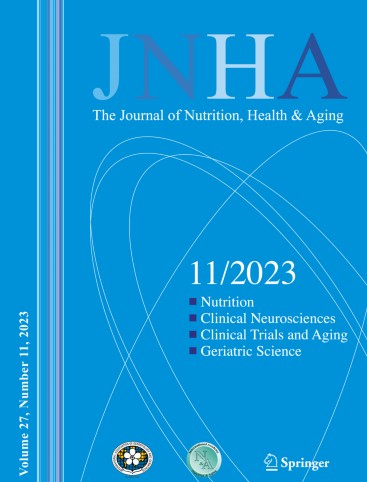美国黑人和白人老年人营养公平指数(NEI)的制定及其与健康饮食指数(HEI)的联系
IF 4.3
3区 医学
Q1 GERIATRICS & GERONTOLOGY
引用次数: 0
摘要
目标我们为美国老年人开发了一种名为营养公平指数(NEI)的新测量方法,其中包括功能能力。我们将营养公平指数和食物不足指数与健康饮食指数 (HEI) 的得分进行了比较。参与者(N = 2468,年龄为 74.7 ± 2.9 岁)拥有基线(1997-1998 年)和 1 年随访的 NEI 数据;以及 1 年随访的食物不足、主要协变量和 HEI(饮食质量测量)数据,这些数据来自由访问者管理的 108 项食物频率问卷。NEI由三个子域中的8个问题构成:食物不安全(食物不足、饥饿、对食物有限的焦虑、购买食物的钱有限)、食物获取(杂货)和食物获取(购物、准备膳食、携带杂货的困难)。最终的营养公平指数类别为低营养公平指数(0)、中营养公平指数(1)和高营养公平指数(2)。多变量线性回归比较了NEI和食物不足与HEI,并对社会人口学、生活方式和合并症等因素进行了调整。结果 在参与者中,13.5%的人存在食物不足,12.1%的人存在低NEI,32.5%的人存在中度NEI。食物不足(vs.食物充足)或低NEI(vs.高NEI)的参与者更有可能是黑人且具有<高中学历(均为p<0.0001)。在最小调整模型中,食物不足与 HEI 分数降低 2.2 分相关(p = 0.001),低 NEI 与 HEI 分数降低 2.6 分相关(p = 0.001),中度 NEI 与 HEI 分数降低 1.0 分相关(p <0.05)。调整种族因素后,NEI 与 HEI 的相关性减弱至不显著。结论在美国老年黑人和白人样本中,食物不足与较低的膳食质量有关。在进行多变量调整之前,NEI 与食物不足在 HEI 关联性方面的表现类似,并且发现了更多存在营养不均的老年人,他们可能面临不良健康后果的风险。本文章由计算机程序翻译,如有差异,请以英文原文为准。
Development of an older adult Nutrition Equity Index (NEI) and association with the Healthy Eating Index (HEI) in older Black and White U.S. adults
Objectives
We developed a novel measure for older U.S. adults called the Nutrition Equity Index (NEI), which includes functional ability. We compared both the NEI and food insufficiency with Healthy Eating Index (HEI) scores.
Design
The Health, Aging, and Body Composition Study is a prospective, longitudinal cohort of Medicare-eligible, community-dwelling Black and White men and women.
Setting
Pittsburgh, PA and Memphis, TN.
Participants
Participants (N = 2468, aged 74.7 ± 2.9 years) had baseline (1997−98) and 1-year follow-up NEI data; and 1 year follow-up for food insufficiency, key covariates, and the HEI (diet quality measure) from a 108-item interviewer-administered food frequency questionnaire.
Measurements
Food insufficiency was defined from a modified validated question on ample food amount/variety from the U.S. Department of Agriculture. NEI was constructed from 8 questions in three subdomains: food insecurity (food insufficiency, hunger, anxiety about limited food, limited money for food), food access (groceries), and food acquisition (difficulty shopping, preparing meals, carrying groceries). Final NEI categories were low nutrition equity (0), moderate nutrition equity (1), and high nutrition equity (2). Multivariable linear regression compared both NEI and food insufficiency with HEI, adjusted for sociodemographic, lifestyle and comorbidity factors.
Results
Of participants, 13.5% had food insufficiency, 12.1% had low NEI, and 32.5% had moderate NEI. Participants with food insufficiency (vs. food sufficiency) or low NEI (vs. high NEI) were more likely to be Black and have < high school education (both p < 0.0001). In minimally adjusted models, food insufficiency was associated with 2.2 point lower HEI score (p = 0.001), low NEI with 2.6 point lower HEI score (p = 0.001), and moderate NEI with 1.0 point lower HEI score (p < 0.05). Adjusting for race attenuated NEI associations with HEI to non-significance. After multivariable adjustment, food insufficiency was associated with 1.5 point lower HEI score (p = 0.03).
Conclusion
Food insufficiency was associated with lower dietary quality in this sample of older Black and White U.S. adults. NEI performed similarly to food insufficiency for HEI associations prior to multivariable adjustment and identified more older adults with nutrition inequity, who may be at risk for poor health outcomes.
求助全文
通过发布文献求助,成功后即可免费获取论文全文。
去求助
来源期刊
CiteScore
7.80
自引率
3.40%
发文量
136
审稿时长
4-8 weeks
期刊介绍:
There is increasing scientific and clinical interest in the interactions of nutrition and health as part of the aging process. This interest is due to the important role that nutrition plays throughout the life span. This role affects the growth and development of the body during childhood, affects the risk of acute and chronic diseases, the maintenance of physiological processes and the biological process of aging. A major aim of "The Journal of Nutrition, Health & Aging" is to contribute to the improvement of knowledge regarding the relationships between nutrition and the aging process from birth to old age.

 求助内容:
求助内容: 应助结果提醒方式:
应助结果提醒方式:


